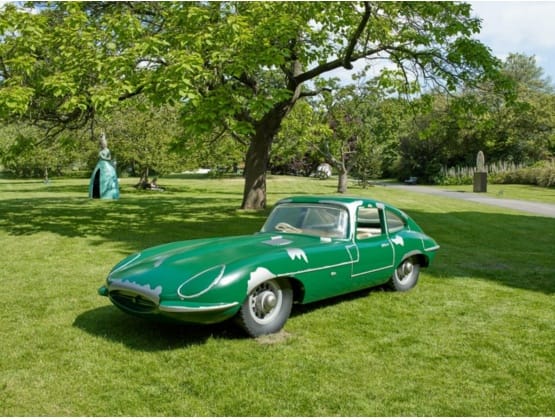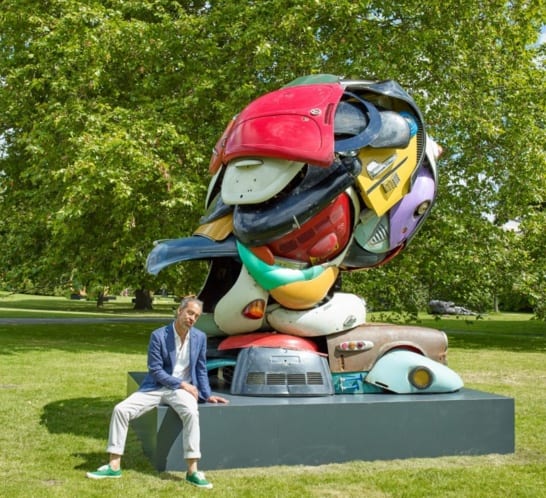03 July 2019 Historically, expensive outdoor art has largely privileged men. The 2019 edition of Frieze Sculpture aims to correct this imbalance.
There’s plenty of lip service paid to diversity in the art world, but no one can accuse this year’s Frieze Sculpture of tokenism. The largest free display of outdoor art in London, which runs this year from July 3 to October 6 in Regent’s Park, is “the most diverse it’s been, and the most international,” says Jo Stella-Sawicka, the fair’s outgoing artistic director, who oversaw the project alongside curator Clare Lilley.
The 20 participating artists, whose works are installed in a green and pleasant corner of the park, range from established names, such as Tom Sachs, Huma Bhabha, Vik Muniz, and Tracey Emin, to rising stars like the young Paris-based Colombian artist Iván Argote, who created a standout work at the Desert X biennial earlier this year. The organizers made a special effort to highlight the work of women, who have historically not been given the resources to create ambitious outdoor work on the same scale as their male peers.
Challenging the art-market status quo in what is, at the end of the day, a selling opportunity—the sculptures are presented by galleries and available for purchase—has never been a walk in Regent’s Park. But if you want something done, give it to a busy curator backed by an artistic director determined to make things happen.
Lilley has juggled organizing Frieze’s sculpture show once again with her day job as program director at the Yorkshire Sculpture Park in the North England. “I have been around the block,” Lilley says, “and traditionally only a tiny number of female artists have received the support needed to fabricate and install outdoor sculpture.”
The support of a gallery or galleries to fund fabrication up front is crucial. Stella-Sawicka cites rising star Rana Begum, who has had multiple solo museum shows but only unveiled her first outdoor piece at Frieze Sculpture last year. (Her colorful, glass minimalist work No. 814 was an Instagram hit—and was promptly snapped up by a collector.)
This year, standout works by young artists include London-based Jodie Carey’s first outdoor bronze, Cord. She cast the delicate vertical column underground in the soil, so imperfections form a random filigree. The artist’s young gallery, Edel Assanti of London, is one of two galleries able to take part in Frieze Sculpture thanks to the sponsorship of art-moving company MTEC.
The public interacts with sculpture in public spaces quite differently than they do in a museum or gallery setting, which artists often enjoy witnessing. Artist Thomas J. Price, who showed a memorable trio of monumental busts of African men at Frieze Sculpture 2017, says works must be “vetted” by the park’s regulars. “People wonder, ‘What are you doing in my space?'” he notes. He found it particularly heartening to witness black people interacting with his work. “It was a dent in the lack of representation,” he says. Most of the editions have sold, and the sculptures can be seen in Price’s solo show at the Power Plant Contemporary Art Gallery in Toronto.
Can’t make it to Regent’s Park to see the work in person? View our pick of five standout works at Frieze Sculpture 2019 below.
Jodie Carey, Cord (2019)
Edel Assanti (London)

Jodie Carey, Cord, (2019), Edel Assanti, Frieze Sculpture 2019. Photo by Stephen White. Courtesy of Stephen White/Frieze.
A rising star, Jodie Carey is a London-based sculptor better known for installations in fabric, wood, or plaster. She literally takes her chances with bronze by casting directly in the earth, which creates delicate nodules and growths like those on the surface of Cord. Carey’s strong but delicate column is a visual metaphor for the unbreakable bond between a mother and child. For more of her work, which begs to be shown outdoors, visit Contemporary Fulmer, a sculpture park near London.
Vik Muniz, Mnemonic Vehicle No.2 (2015)
Ben Brown Fine Arts (London, Hong Kong)

Vik Muniz, Mnemonic Vehicle No.2 (2015). Courtesy of Stephen White/Frieze.
The Brazilian artist Vik Muniz’s supersize toy car appeals to the child in all of us. Playfully innocent, it is hard to imagine this vehicle cutting you up in London traffic. The artist was quick to Instagram his pride and joy, explaining that it is based on a beloved childhood toy—that’s why the Jaguar E-type’s paintwork shows signs of wear and tear. “The piece is a perfect reconstruction of a Matchbox [car] from my childhood that I found in a drawer on the scale of the real car and the same materials,” Muniz explained.
Joanna Rajkowska, The Hatchling (2019)
l’étrangère (London)

Joanna Rajkowska, The Hatchling (2019). Presented by l’etrangere at Frieze Sculpture. Courtesy of Stephen White/Frieze.
Is it a bird’s egg? Is it an alien? The lure of the Poland-born, London- and Warsaw-based artist’s giant bronze egg is irresistible. If you stand close to Rajkowska’s sculpture—or better yet, put your ear up against it—you will hear and feel what could be a flock of baby birds about to hatch. It’s about the circle of life—but not quite as we know it.
Robert Indiana, ONE Through ZERO (1980–2002)
Waddington Custot (London)

Robert Indiana, ONE Through ZERO (1980–2002). Copyright Morgan Art Foundation Ltd. / Artists Rights Society (ARS), New York, DACS, London 2019. Photo by Stephen White. Courtesy of Stephen White/Frieze.
Robert Indiana’s circle of monumental numerals form a different take on the cycle of life. The big “one” represents birth, while the “zero” could be the big studio in the sky. It is refreshing to be reminded of Indiana’s art when his legacy has been overshadowed by the legal battle that ignited upon his death. ONE Through ZERO is an authentic Indiana experience in the heart of London. What’s not to love?
Zak Ové, Autonomous Morris (2018)
Lawrie Shabibi (Dubai)

Zak Ové, Autonomous Morris (2018). Lawrie Shabibi, Frieze Sculpture 2019. Photo by Stephen White. Courtesy of Stephen White/Frieze.
Zak Ové has long been transforming found objects into art—but rarely on this scale, and with such va-va-voom. His giant beaked head made of assorted car hoods arrives in Regent’s Park hot on the heels of the opening of the critically acclaimed exhibition of Caribbean artists active in the UK that Ové curated at London’s Somerset House. His 2018 sculpture has clocked up a few miles already, having made its debut in the West End of London during Frieze last autumn. It references cultural migration on a much deeper level, however. Its title, several vintage Morris Minor bonnets, and other vintage car parts refer to the ancient British tradition of Morris Dancing, which has roots that can be traced back to Europe and as far afield as North Africa.
Frieze Sculpture 2019 is on view from July 3 through October 6 at the English Garden in Regent’s Park, London.

